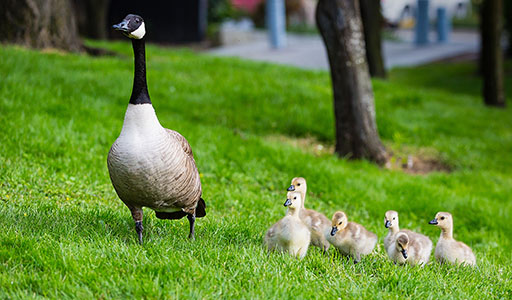Geese

Geese Information
he Canada goose is a large wild bird native to the northernmost regions of North America. Geese can cause large problems for homeowners in both urban and suburban areas. On your property, flocks of geese can make a lot of noise and can disrupt your everyday life quite easily. Geese will wander into more residential areas in search of grass, grains, and aquatic plants to consume. However, if you feed geese that show up on your property, they are more likely to return. Geese may bite if they come in contact with small children or animals on your property. When flocks of geese arrive on your property, they can cause issues in the form of defecation.

What does a Geese look like?
Canada geese are common throughout most of the United States. Recognizable by their large size, the birds have distinct black necks and heads, white cheeks, brown body feathers, and white bellies. Their large, webbed feet make them powerful swimmers and their sizable wingspans allow them to fly high in the air for distances up to 1,500 miles per day. When threatened, Canada geese hiss, flap their wings intimidatingly, and bite with their beaks. They make loud honking sounds to communicate with each other, especially when flying.

What does a Geese eat?
Geese typically eat aquatic plants, grain crops, and grasses. Their favorite foods are generally found in ponds, marshy areas, farms, and open spaces like public parks.

Geese habitats
Fields, marshes, and grasslands adjacent to open water such as ponds, lakes, and slow-moving rivers make prime habitats for Canada geese. City parks, public ponds, golf courses, and farm fields are also common feeding grounds and nesting sites. Their nests are often found near the water’s edge and are made from the abandoned nests of other waterfowl. When constructing their own nests, Canada geese tend to choose sheltered sites among tall reeds or cattails in which they build bowl-like structures made of twigs and reed stalks.
Finding a Goose in the House
Geese thrive in areas with easy access to waterways and are often found on private properties searching for food and nesting sites. While hanging around on lawns, the pests occasionally find their way inside homes, especially if people feed them. If geese become accustomed to being fed by humans, they will feel more comfortable wandering inside through open windows or doors to track down their expected meals.
Damage & Problems
Having a goose on the roof can cause several issues. Geese will eat tar and other roofing materials, which compromises structural integrity. Furthermore, their droppings accumulate in large amounts. The acidity in geese excrement also eats away at roofs and clogs drains. In fact, the longevity of roofs can be cut in half by the presence of goose droppings.
The pests may also mistakenly fly into chimneys and find their way into homes. Additionally, geese can spread a number of parasites, bacteria, viruses, and fungi.


